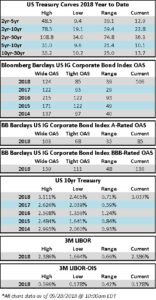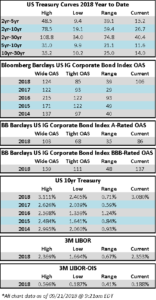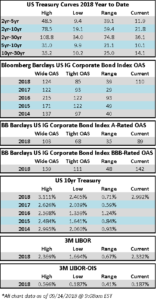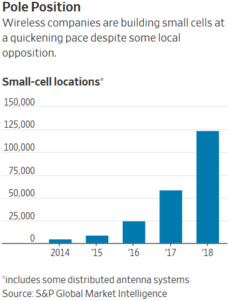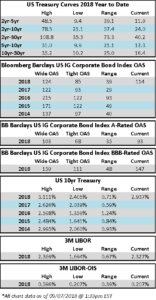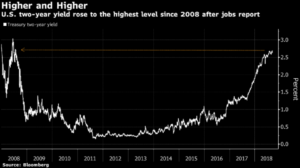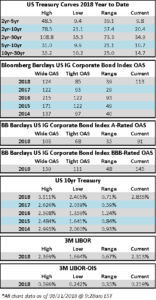Fund Flows & Issuance: According to a Wells Fargo report, flows week to date were $2.3 billion and year to date flows stand at -$34.0 billion. New issuance for the week was $4.7 billion and year to date HY is at $151.7 billion, which is -27% over the same period last year.
(Bloomberg) High Yield Market Highlights
- The lowest-rated junk bonds came under pressure, with CCC-rated debt yields hitting a six-month high, as global bond markets sold off. The spread on the Bloomberg Barclays High Yield Index meanwhile hit a fresh 11-year low.
- Triple-C yield jumped to almost 9.3% after the biggest rise in more than seven years
- Treasury moves and drifting stocks pressured junk bonds across ratings, rate-sensitive BBs and single-Bs were hit hardest
- Stocks lost steam amid concerns that Fed hikes, coupled with WTI at a new multi-year high, may cause economic slowdown
- Lack of supply continued, with just Covanta Holding pricing a $400m 8NC3 offering at the tight end of talk after receiving orders of more than $1b
- Junk bond spreads dropped to new lows as the 5Y and 10Y Treasury yields hit a fresh multi-year high yesterday
(Digitimes) HDD demand for enterprise data centers remains robust, says WD executive
- HDD demand for enterprise data centers continues to be strong, according to Christopher Bergey, executive VP at Western Digital (WD).
- In the enterprise data center segment, HDD demand has as high as 40% annual growth, Bergey said. There is still a gap between SSD and HDD prices, though the industry’s transition to 3D NAND manufacturing has been dragging down SSD prices, Bergey indicated.
- Traditional hard drive storage is well suited for handling massive big data analytics to support machine learning, while solid state storage provides fast read and write speeds to allow fast and efficient decision making, Bergey said.
- Bergey continued that it is difficult to assume SSDs will completely replace HDDs given that the latter has its lower cost per unit storage. While SSDs are set to become a broadly use storage technology, the market for HDDs will become more condensed, Bergey suggested.
- WD is also a SSD provider. Sales of both the company’s SSD and HDD lines continue their growth momentum, Bergey said.
(CNBC) DaVita shares rise after California bill capping dialysis payments is vetoed
- Shares of dialysis clinic operator DaVita rose more than 3 percent on Monday after California’s governor vetoed a bill that would have cut into its sales.
- The bill, which was vetoed by Gov. Jerry Brown on Sunday, would have limited reimbursements for financial assistance to dialysis patients. That assistance is used by companies to maximize their reimbursements and can drive up premium costs.
- CEO Javier Rodriguez said in a statement the bill “would have harmed thousands of dialysis patients in California by allowing health plans to discriminate against low-income dialysis patients who rely on charitable assistance to pay their insurance premiums.” He also noted the company was “deeply relieved” the bill was vetoed.
- Though this is seemingly a win for DaVita, one of the largest kidney care provider in the U.S., but it all depends on what happens next month. California voters will have a chance to vote on a ballot that would limit how much revenue dialysis providers can earn from commercially insured individuals.
(Bloomberg) Sky High Valuations in CCC Bonds
- Although the riskiest U.S. corporate bonds have been a great bet this year, some money managers think high valuations mean it’s finally time to sell.
- Company bonds that are the most likely to default, rated in the CCC tier, have gained more than 6% this year including interest, while the rest of the junk-bond universe is up just 2.2%. But Bank of America analysts recently warned that the riskiest junk bonds seem to be losing momentum, and investors should consider switching into safer securities.
- Bank of America strategists led by Oleg Melentyev advised investors last week to trim their exposure to CCC debt, saying that most of the bonds’ gains relative to higher-rated speculative-grade debt occurred in the first half of the year. The current extra return investors are getting to hold the notes isn’t “the right level of compensation for the amount of credit risk investors are taking,” they wrote.
(Bloomberg) Teleflex Buys Essential Medical; Terms Not Disclosed
- Teleflex says it acquired privately-held Essential Medical Inc., developer of the “Manta” device.
- Company sees deal modestly adding to constant currency revenue growth and gross margins over multi-year period after the anticipated FDA premarket approval of the Manta device in 2019
- Device “specifically designed for closure of large bore arteriotomies following procedures utilizing devices or sheaths ranging in size from 10F to 18F (with maximum outer diameters up to 25F)”
(Business Wire) Arconic Announces Sale of Its Texarkana, Texas, Rolling Mill
- Arconic announced today that it has reached an agreement to sell its Texarkana, Texas rolling mill to Ta Chen International, Inc., a U.S. subsidiary of aluminum and stainless steel distributor Ta Chen Stainless Pipe Co., Ltd. Under the terms of the transaction, Arconic will sell Texarkana for approximately $300 million in cash, plus additional contingent consideration of up to $50 million. The transaction is expected to close in the fourth quarter of 2018, subject to receipt of certain regulatory approvals and other customary closing conditions. The Company expects to record a gain on the sale.
